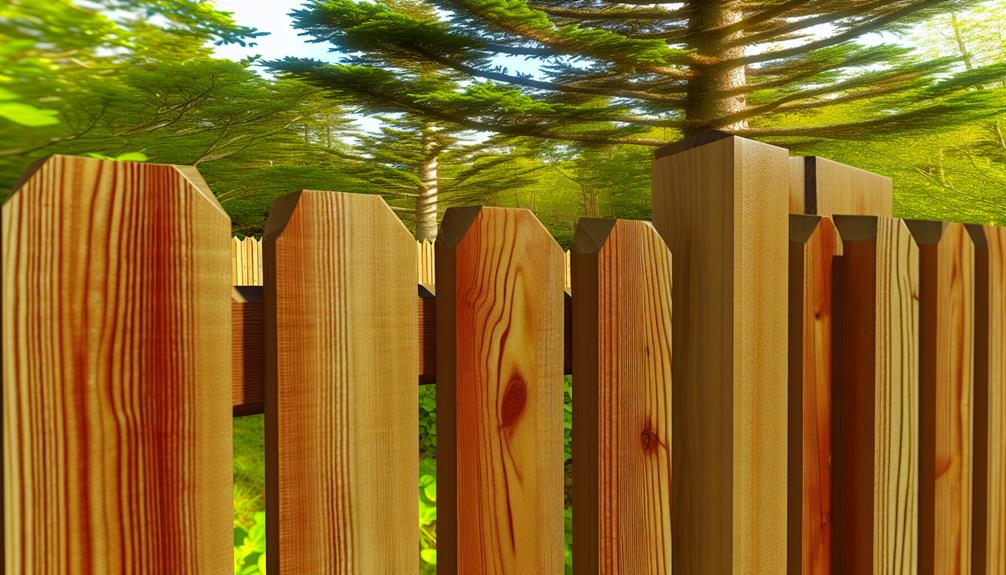When selecting cedar fence pickets, prioritize quality for both durability and style. Western Red Cedar, known for its rich hues and natural resistance to decay and insects, is an excellent choice. Select thicker pickets for enhanced weather resistance, privacy, and aesthetic versatility. Understand grading standards to guarantee you choose material suitable for your design vision. Consider treatment options for added protection against elements. Regular maintenance, including cleaning and sealant application, prolongs your fence's life and beauty. Exploring various design styles and cost factors will further refine your decision-making process. Additional insights await those interested in maximizing their cedar fencing investment.
Key Takeaways
- Choose Western Red Cedar for superior durability, decay resistance, and attractive grain patterns that enhance aesthetic appeal.
- Select thicker pickets to improve weather resistance, privacy, and reduce maintenance frequency over time.
- Consider natural oil treatments to maintain cedar's beauty while providing moisture and UV protection.
- Opt for clear grading for high-end projects or lower grades for budget-friendly options while ensuring structural integrity.
- Match picket color and design style to your property's character, creating a cohesive and appealing outdoor space.
Benefits of Cedar Fencing
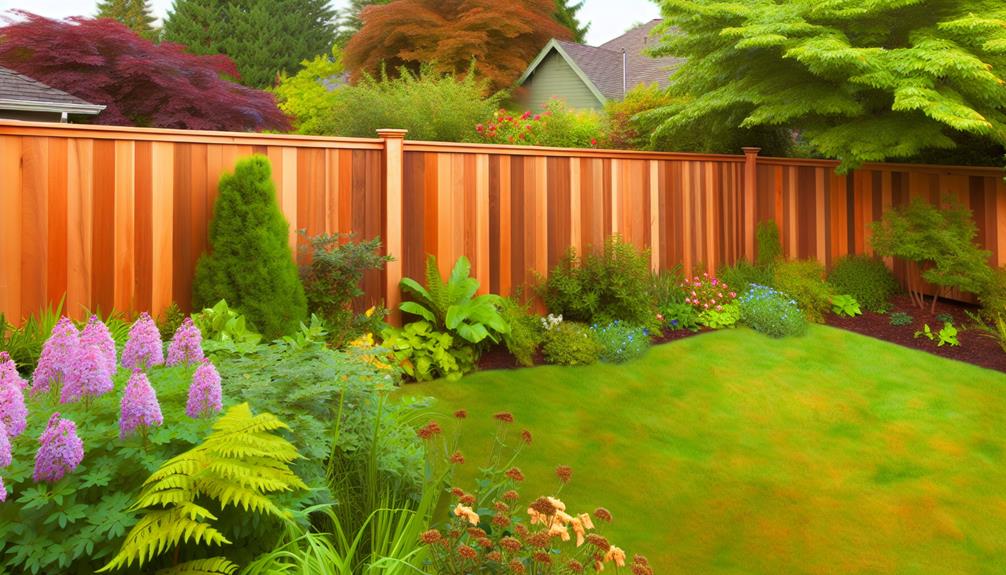
Cedar fencing consistently stands out as a superior choice for homeowners seeking both aesthetic appeal and functional durability. One of the most compelling benefits of cedar fencing is its inherent environmental sustainability. Cedar is a renewable resource, and its growth process requires considerably less energy compared to synthetic alternatives. This characteristic aligns with the values of eco-conscious homeowners who prioritize responsible choices for their properties. Additionally, homeowners looking to invest in cedar fencing can discover profitable local businesses for sale that specialize in sustainable products and services.
Moreover, cedar possesses natural resistance to decay, insects, and moisture, which enhances its longevity without the need for chemical treatments. This natural resistance not only reduces maintenance costs over time but also contributes to a healthier environment. Homeowners can take pride in knowing that their cedar fence is both a beautiful addition to their landscape and a sustainable choice that minimizes ecological impact.
The warm hues and attractive grain patterns of cedar further elevate its appeal, creating an inviting atmosphere that fosters a sense of belonging within the community. By choosing cedar fencing, homeowners are not just investing in a functional boundary; they are embracing a lifestyle that values beauty, durability, and environmental stewardship, making it a truly exceptional option for any property.
Types of Cedar Wood
When considering cedar fencing, it is important to recognize that not all cedar wood is created equal. The two primary types of cedar commonly used in fencing are Western Red Cedar and Eastern White Cedar, each possessing unique characteristics that influence their suitability for various applications.
| Type of Cedar | Key Features |
|---|---|
| Western Red Cedar | Known for its rich, reddish hue and aromatic properties, it is highly resistant to decay and insects. Its fine grain patterns contribute to a visually appealing finish, making it a popular choice for aesthetic fencing. |
| Eastern White Cedar | Lighter in color and weight, it offers good durability but may not match the decay resistance of Western Red. Its cost differences can make it more attractive for budget-conscious projects, though availability issues can arise due to harvesting pressures. |
Both types align with sustainability practices, as cedar is often sourced from responsibly managed forests. However, the environmental impact of sourcing can vary, with Western Red Cedar sometimes facing greater scrutiny. Understanding these distinctions is essential in making an informed choice that balances durability, style, and ecological responsibility.
Grading Standards Explained
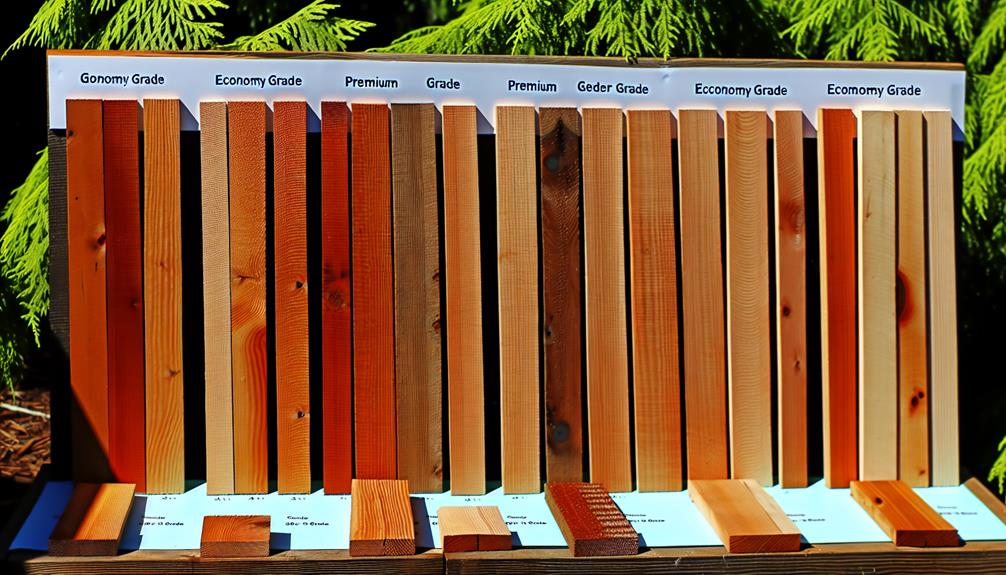
Understanding grading standards is essential for selecting the right cedar fence pickets, as these classifications directly affect quality, appearance, and longevity. The grading criteria used in cedar lumber categorizes wood based on its visual characteristics, structural integrity, and overall performance. Typically, the classifications range from clear grades, which feature minimal imperfections, to lower grades that exhibit knots and other natural blemishes. For those looking to enhance their career and skills in a related field, consider exploring business analytics opportunities.
Clear grades are ideal for those seeking a polished aesthetic and are often employed in high-end projects. In contrast, lower-grade pickets may be more economical, yet they come with increased variability in appearance and durability. Each classification serves a unique purpose, allowing homeowners to choose pickets that align with both their design vision and functional needs.
Additionally, understanding these grading classifications can foster a sense of belonging within a community that values craftsmanship and quality. By selecting the appropriate grade, individuals not only enhance their property's visual appeal but also contribute to a collective standard of excellence in outdoor living spaces. Ultimately, informed choices regarding grading standards empower homeowners to invest in cedar fence pickets that reflect their personal style and commitment to longevity.
Selecting the Right Thickness
Choosing the appropriate thickness for cedar fence pickets is vital for ensuring both structural stability and aesthetic appeal. The thickness of the pickets considerably impacts the overall durability of the fence and influences its visual presence in your outdoor space. When evaluating thickness, it is important to take into account the benefits and compare different options to find the right fit for your needs. Additionally, understanding how different materials can enhance your outdoor environment can lead to more informed decisions, similar to how fitness sales careers at Crunch Fitness offer unique opportunities for growth in personal development.
- Enhanced durability: Thicker pickets withstand weather elements better, reducing repair frequency.
- Aesthetic versatility: Different thicknesses can create distinct visual effects, complementing various architectural styles.
- Privacy assurance: Thicker pickets provide better coverage, enhancing privacy for your outdoor areas.
- Cost-effectiveness: Investing in thicker pickets may lead to fewer replacements, ultimately saving money.
- Installation ease: Thicker materials can be easier to install, ensuring a more stable and secure structure.
Thickness comparisons reveal that while thinner pickets may be more economical, they often compromise long-term performance. As a result, selecting the right thickness is not merely a matter of preference but a decision that influences the longevity and charm of your cedar fence. Ultimately, embracing the right thickness fosters a sense of belonging and pride in your outdoor environment.
Treatment and Preservation Options
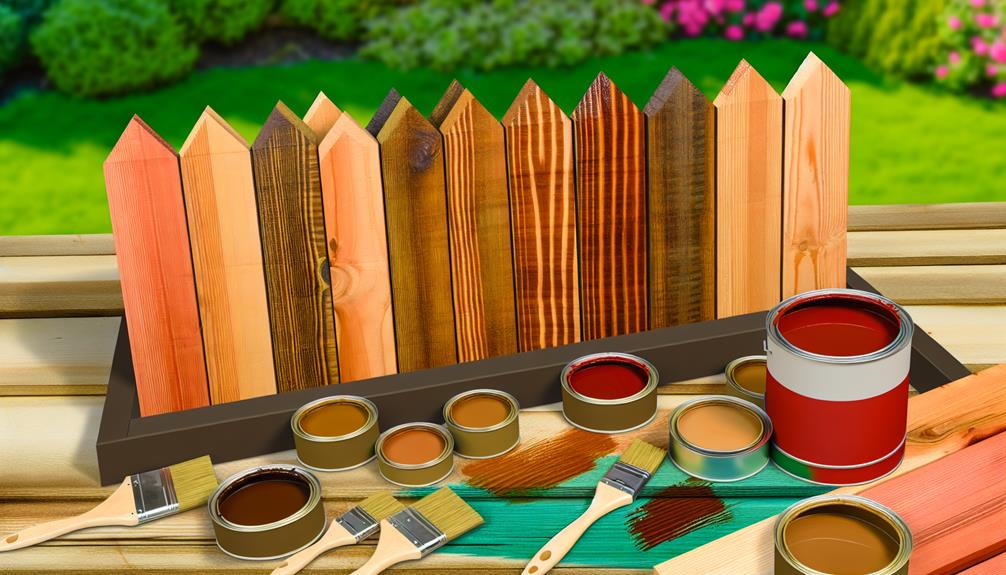
To guarantee the longevity and aesthetic appeal of cedar fence pickets, understanding treatment and preservation options is essential. Various wood treatments, sealants, and stains can greatly enhance the durability of cedar while protecting it from environmental factors. Moreover, just as one might explore diverse fitness programs to achieve health goals, considering the right fitness programs for your wood can lead to ideal results. In addition, implementing a consistent maintenance routine will help retain the wood's natural beauty and integrity over time.
Types of Wood Treatments
Several wood treatment options exist to enhance the durability and longevity of cedar fence pickets, each catering to specific environmental conditions and aesthetic preferences. When selecting appropriate treatments, understanding wood preservatives and their treatment applications is essential. These treatments provide protection against decay, insects, and weathering, ensuring that your fence remains both functional and visually appealing.
Consider the following types of wood treatments:
- Pressure-treated wood preservatives: Infuse the wood with chemicals to resist rot and insect damage.
- Natural oil treatments: Enhance the wood's natural beauty while offering some resistance against moisture and UV rays.
- Borate treatments: Provide effective protection against fungi and insects without compromising the wood's aesthetics.
- Water-repellent preservatives: Help to prevent moisture absorption, reducing the risk of warping and splitting.
- Synthetic sealers: Offer a robust protective layer that can extend the lifespan of your fence in harsh climates.
Sealants and Stains
When it comes to enhancing the longevity and appearance of cedar fence pickets, sealants and stains play an important role in treatment and preservation. These products not only protect the wood from the elements but also allow homeowners to personalize their outdoor space with style.
Sealant application is crucial for preventing moisture intrusion, which can lead to warping and decay. A high-quality sealant creates a barrier that repels water and minimizes the effects of UV rays, preserving the natural beauty of the wood. It is important to select a sealant compatible with cedar, ensuring maximum adhesion and performance.
On the other hand, stain options provide both aesthetic appeal and protection. Stains are available in various shades, allowing homeowners to enhance the natural grain of cedar while adding color. They also contain UV blockers that help prevent fading over time. When choosing a stain, consider whether a transparent or semi-transparent option aligns with your vision for your outdoor space.
Incorporating these treatments not only enhances the durability of cedar fence pickets but also cultivates a welcoming atmosphere in your outdoor environment, making it an extension of your home.
Maintenance and Care
Effective maintenance and care are essential for preserving the integrity and beauty of cedar fence pickets over time. By implementing a structured approach to treatment and preservation, homeowners can guarantee their investment remains visually appealing and functional. Regular maintenance not only prolongs the life of the fence but also enhances the overall aesthetic of the property.
To effectively maintain cedar fence pickets, consider the following:
- Regular Cleaning Techniques: Utilize a mild soap solution and a soft brush to remove dirt and debris.
- Inspection for Damage: Routinely check for signs of wear, rot, or insect infestations.
- Repair Tips: Promptly address any damage by replacing broken pickets or applying wood filler to small cracks.
- Application of Sealants: Reapply high-quality sealants or stains every few years to protect against moisture and UV rays.
- Seasonal Care: Adjust maintenance practices based on seasonal changes, guaranteeing adaptability to various weather conditions.
Aesthetic Considerations
Aesthetic considerations play an essential role in selecting cedar fence pickets, as the color options available can greatly influence the overall look of a property. Homeowners must also explore various design styles to guarantee that the fence complements the architectural features of their home and enhances the surrounding landscape. For instance, just as group fitness classes cater to different preferences, selecting the right fence design can elevate the visual appeal of any outdoor space. By thoughtfully evaluating these elements, one can achieve a visually appealing and cohesive outdoor space.
Color Options Available
Cedar fence pickets offer a range of color options that can greatly influence the overall appearance and feel of a property. Selecting the right color not only enhances the aesthetic appeal but also reflects personal style and complements the surrounding landscape. Homeowners can choose from various shades, each offering unique benefits and visual impact.
- Light colors: These create an airy, inviting atmosphere and can make spaces feel larger.
- Dark hues: Provide a sophisticated, modern look, often associated with luxury and elegance.
- Natural finishes: Highlight the inherent beauty of cedar wood, showcasing its unique grain patterns.
- Painted options: Allow for vibrant expressions of personality, aligning with current color trends.
- Stain choices: Offer a range of tones while preserving the wood's natural texture, ensuring durability.
Design Styles Choices
While selecting the right design style for cedar fence pickets, homeowners must consider how various aesthetics can enhance the overall ambiance of their outdoor spaces. The choice between styles can greatly impact not only the visual appeal but also the emotional resonance of the environment.
For those drawn to a modern minimalist aesthetic, clean lines and simple forms are paramount. This design approach often favors horizontal pickets, which create an open and airy feel, allowing the surrounding landscape to breathe. The understated elegance of this style promotes a sense of tranquility and sophistication.
Conversely, the classic farmhouse style embraces a more traditional and rustic charm. Here, vertical pickets with a slightly distressed finish can evoke feelings of warmth and nostalgia. This design choice resonates with those seeking a sense of belonging and connection to the past, creating an inviting atmosphere that welcomes family and friends.
Ultimately, the decision between modern minimalist and classic farmhouse styles hinges on personal preferences and the desired mood of the outdoor space. Both options offer unique benefits, allowing homeowners to curate a fence that reflects their individuality and enhances their property's character.
Maintenance Tips for Longevity

How can you guarantee that your cedar fence pickets remain in excellent condition for years to come? Understanding and implementing effective maintenance strategies is essential for preserving the beauty and durability of your fence. Regular upkeep not only enhances its aesthetic appeal but also extends its lifespan, making certain that your investment remains valuable.
To maintain your cedar fence, consider the following tips:
- Regular Cleaning: Utilize gentle cleaning techniques, such as a soft brush and mild soap, to remove dirt and debris.
- Inspect for Damage: Conduct seasonal checks to identify any signs of wear, rot, or insect infestation.
- Apply Protective Finishes: Use a quality sealant or stain to protect the wood from moisture and UV damage.
- Trim Vegetation: Keep plants and grass away from the fence to prevent moisture buildup and decay.
- Reinforce Structural Integrity: Make sure that fence posts are secure and that any loose pickets are promptly fixed.
Cost Factors to Consider
When investing in a cedar fence, understanding the various cost factors involved is essential for making informed financial decisions. The first aspect to evaluate is fence pricing, which can vary greatly based on quality, size, and design. Higher-quality cedar pickets will generally command a premium price due to their enhanced durability and aesthetic appeal, making them a worthy investment for those who value longevity.
Another critical factor is material sourcing. The origin of your cedar can influence not only cost but also the environmental impact of your purchase. Locally sourced materials may offer cost advantages and contribute to sustainability, while imported materials could incur additional shipping expenses. Additionally, be aware of market fluctuations and seasonal demands that can affect pricing.
It's also prudent to account for potential hidden costs, such as delivery fees and taxes. By thoroughly analyzing these cost factors, you can better align your budget with your goals, ensuring that your cedar fence not only enhances your property's charm but also reflects your commitment to quality and sustainability. Ultimately, a well-evaluated investment will foster a sense of belonging and pride in your outdoor space.
Installation Best Practices
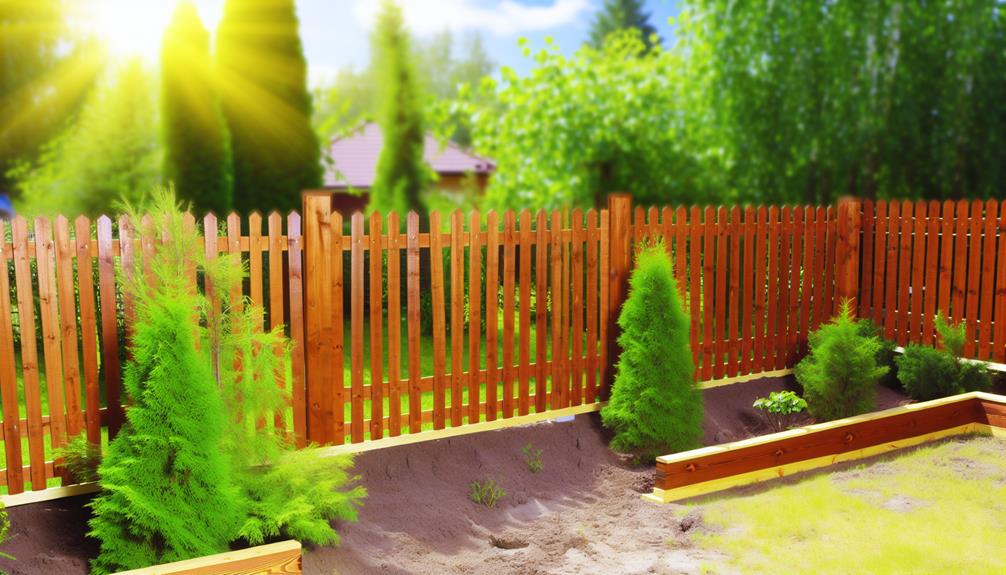
Successfully installing cedar fence pickets requires careful planning and adherence to best practices to secure durability and aesthetic appeal. Proper fence installation not only enhances the beauty of your property but also fosters a sense of belonging within your neighborhood. To achieve a professional finish, consider the following best practices:
- Plan Your Layout: Measure your yard accurately and determine the desired height and length of your fence.
- Choose the Right Tools: Utilize quality tools such as a post hole digger, level, and saw to secure precision.
- Establish Picket Spacing: Maintain consistent spacing between each picket to create a uniform look while allowing for expansion and contraction.
- Use Quality Fasteners: Select corrosion-resistant screws or nails to prolong the life of your fence and minimize maintenance.
- Seal and Stain: Apply a protective sealant or stain to your cedar pickets to enhance their natural beauty and protect against weather elements.
Comparing Cedar to Other Materials
When considering fencing options, cedar stands out against pressure-treated wood and vinyl for several reasons. While pressure-treated wood offers durability at a lower cost, it may require more maintenance due to chemical treatments. Conversely, vinyl fencing provides a maintenance-free solution but lacks the natural aesthetic and appeal that cedar inherently possesses.
Cedar vs. Pressure-Treated Wood
Choosing the right material for fence pickets can greatly impact both aesthetics and durability, leading many homeowners to weigh the benefits of cedar against those of pressure-treated wood. Cedar is renowned for its natural beauty and resistance to decay, providing an inviting appearance that blends harmoniously with nature. Its unique oils also deter insects, minimizing maintenance concerns. Conversely, pressure-treated wood is celebrated for its durability, making it a reliable choice for homeowners seeking long-lasting performance.
When comparing these two materials, consider the following:
- Aesthetic Appeal: Cedar offers a warm, rustic charm, while pressure-treated wood has a more utilitarian look.
- Longevity: Pressure-treated wood typically lasts longer in harsh conditions, but cedar can outlast in milder climates.
- Maintenance: Cedar requires less upkeep due to its natural properties, while pressure-treated wood may need regular staining or sealing.
- Environmental Impact: Cedar is often sourced sustainably, whereas the chemicals used in pressure treatment raise environmental concerns.
- Cost: Cedar generally comes at a higher initial cost but may reduce long-term maintenance expenses.
Ultimately, the choice hinges on balancing cedar benefits with pressure-treated durability to suit your specific fencing needs.
Cedar vs. Vinyl Fencing
Comparing cedar fencing to vinyl reveals a distinct divergence in aesthetics, maintenance, and environmental impact. Cedar fencing advantages stem largely from its natural beauty and warm tones that blend effortlessly into various landscapes, creating an inviting atmosphere. In contrast, vinyl fencing offers a more uniform appearance, which some may find less appealing regarding character and charm.
When discussing durability, vinyl fencing excels due to its resilience against weather elements, rot, and pests, making it a low-maintenance option for homeowners. This longevity is often a selling point; however, it comes at the cost of a less authentic feel. Cedar, while requiring periodic maintenance such as staining or sealing, provides a naturally durable material that can last for decades when properly cared for.
Moreover, the environmental impact of these materials is worth noting. Cedar is a renewable resource that, when sourced sustainably, aligns with eco-friendly practices. Vinyl, while durable, is derived from petroleum, raising concerns about its long-term sustainability. Ultimately, the choice between cedar and vinyl fencing hinges on personal preference and values, balancing aesthetics, maintenance, and environmental considerations.
Frequently Asked Questions
How Long Can Cedar Fence Pickets Last With Proper Maintenance?
Cedar fence pickets exhibit a lifetime expectancy of approximately 15 to 30 years, contingent upon proper maintenance. To maximize longevity, homeowners should implement maintenance tips such as regular sealing, staining, and inspection for signs of wear or damage. Additionally, ensuring proper drainage and ventilation around the fence can mitigate moisture-related issues. By adhering to these practices, one can enhance the durability and aesthetic appeal of their cedar fence, fostering a sense of belonging in their outdoor space.
Can I Paint or Stain Cedar Fence Pickets Easily?
Cedar fence pickets can indeed be painted or stained with relative ease, provided the correct techniques are employed. When considering painting techniques, it's crucial to prepare the surface properly to guarantee adhesion and longevity. Alternatively, staining options allow the natural beauty of cedar to shine through while providing protection. Both methods enhance the aesthetic appeal and can extend the lifespan of the fence, fostering a sense of belonging and pride in one's outdoor space.
Are There Eco-Friendly Options for Cedar Fencing?
When considering eco-friendly options for cedar fencing, sustainable sourcing is paramount. Look for companies that prioritize responsibly harvested cedar, ensuring minimal environmental impact. Additionally, some manufacturers offer fencing constructed from recycled materials, which can greatly reduce landfill waste while maintaining aesthetic appeal. These options not only enhance the natural beauty of your property but also foster a sense of belonging to a community that values environmental stewardship and sustainable practices.
What Pests Are Most Likely to Damage Cedar Wood?
Cedar wood, while naturally resistant to decay, can still fall prey to various pests that jeopardize its integrity. Common culprits include termites, carpenter ants, and wood-boring beetles. Pest identification is essential in mitigating damage; timely detection allows for effective wood preservation strategies to be implemented. Regular inspections and maintenance not only prolong the life of cedar but also foster a sense of belonging within communities that prioritize sustainable and resilient outdoor spaces.
How Do Weather Conditions Affect Cedar Fence Durability?
Weather conditions considerably influence the durability of cedar fences, primarily through moisture impact and UV exposure. Prolonged exposure to moisture can lead to wood warping and decay, while UV rays can cause discoloration and weaken the wood fibers, reducing structural integrity. To enhance longevity, it is vital to apply protective sealants and regularly maintain the fence. Understanding these environmental factors guarantees that cedar fences retain their aesthetic appeal and functional strength over time.

